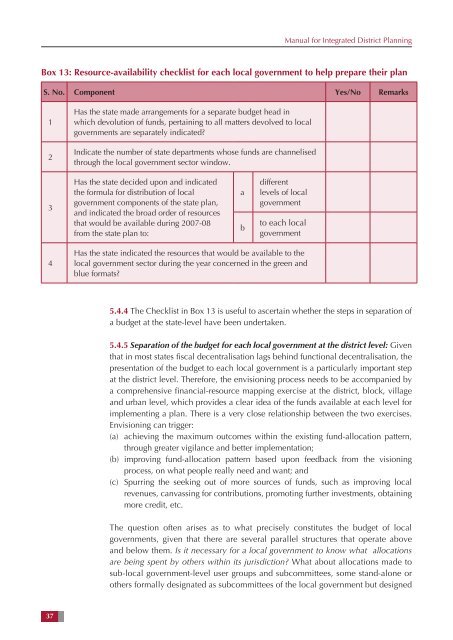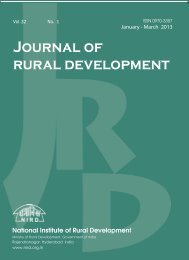Manual for Integrated District Planning - National Institute of Rural ...
Manual for Integrated District Planning - National Institute of Rural ...
Manual for Integrated District Planning - National Institute of Rural ...
You also want an ePaper? Increase the reach of your titles
YUMPU automatically turns print PDFs into web optimized ePapers that Google loves.
<strong>Manual</strong> <strong>for</strong> <strong>Integrated</strong> <strong>District</strong> <strong>Planning</strong><br />
Box 13: Resource-availability checklist <strong>for</strong> each local government to help prepare their plan<br />
S. No. Component Yes/No Remarks<br />
1<br />
2<br />
Has the state made arrangements <strong>for</strong> a separate budget head in<br />
which devolution <strong>of</strong> funds, pertaining to all matters devolved to local<br />
governments are separately indicated?<br />
Indicate the number <strong>of</strong> state departments whose funds are channelised<br />
through the local government sector window.<br />
3<br />
Has the state decided upon and indicated<br />
the <strong>for</strong>mula <strong>for</strong> distribution <strong>of</strong> local<br />
government components <strong>of</strong> the state plan,<br />
and indicated the broad order <strong>of</strong> resources<br />
that would be available during 2007-08<br />
from the state plan to:<br />
a<br />
b<br />
different<br />
levels <strong>of</strong> local<br />
government<br />
to each local<br />
government<br />
4<br />
Has the state indicated the resources that would be available to the<br />
local government sector during the year concerned in the green and<br />
blue <strong>for</strong>mats?<br />
5.4.4 The Checklist in Box 13 is useful to ascertain whether the steps in separation <strong>of</strong><br />
a budget at the state-level have been undertaken.<br />
5.4.5 Separation <strong>of</strong> the budget <strong>for</strong> each local government at the district level: Given<br />
that in most states fiscal decentralisation lags behind functional decentralisation, the<br />
presentation <strong>of</strong> the budget to each local government is a particularly important step<br />
at the district level. There<strong>for</strong>e, the envisioning process needs to be accompanied by<br />
a comprehensive financial-resource mapping exercise at the district, block, village<br />
and urban level, which provides a clear idea <strong>of</strong> the funds available at each level <strong>for</strong><br />
implementing a plan. There is a very close relationship between the two exercises.<br />
Envisioning can trigger:<br />
(a) achieving the maximum outcomes within the existing fund-allocation pattern,<br />
through greater vigilance and better implementation;<br />
(b) improving fund-allocation pattern based upon feedback from the visioning<br />
process, on what people really need and want; and<br />
(c) Spurring the seeking out <strong>of</strong> more sources <strong>of</strong> funds, such as improving local<br />
revenues, canvassing <strong>for</strong> contributions, promoting further investments, obtaining<br />
more credit, etc.<br />
The question <strong>of</strong>ten arises as to what precisely constitutes the budget <strong>of</strong> local<br />
governments, given that there are several parallel structures that operate above<br />
and below them. Is it necessary <strong>for</strong> a local government to know what allocations<br />
are being spent by others within its jurisdiction? What about allocations made to<br />
sub-local government-level user groups and subcommittees, some stand-alone or<br />
others <strong>for</strong>mally designated as subcommittees <strong>of</strong> the local government but designed<br />
37

















